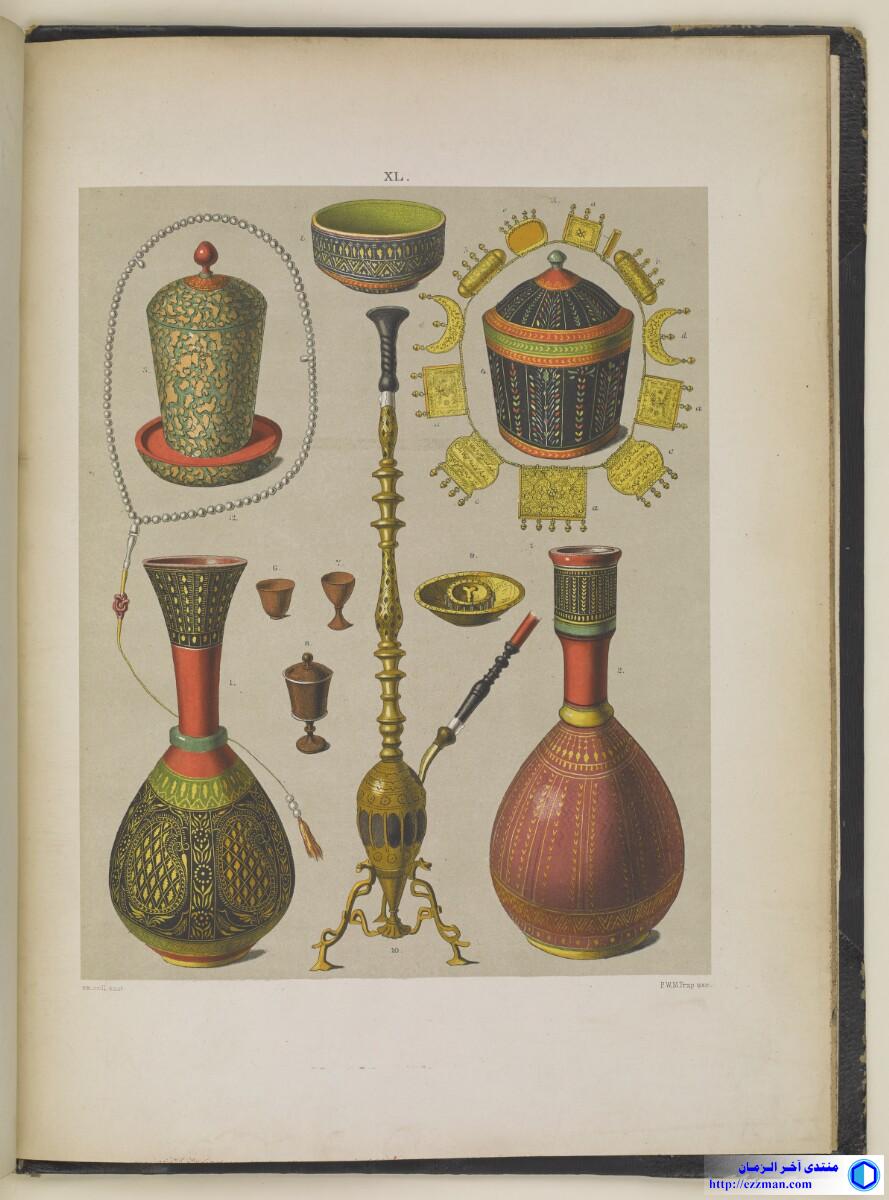
Content
Genre/Subject Matter:
This lithographic print shows objects and utensils in common use in Mecca. The items are drawn from the collection of Christiaan Snouck Hugronje and the illustration was printed by Pieter Willem Marinus Trap, the lithographic printer of the journal Internationales Archiv für Ethnographie .
The objects are itemised in the list of plates at the beginning of the volume. Each object is identified by a number, which refers to elements in this list. The information in square brackets has been taken from a contemporaneous essay by Snouck Hurgronje entitled ‘Ethnographisches aus Mekka’, which was published in Internationales Archiv für Ethnographie , Vol. I, Leiden, 1888.
They are as follows:
1 Schèrbah (hِlzerner Wasserkrug) [Wooden water pitcher, vase-shaped; the interior of the neck opening red.]
2 Rub’ī (hِlzerner Wasserkrug) [Wooden water pitcher, vase-shaped; with narrow neck that is less than half as narrow as the above and the interior is red. Bell with metallic reflex.]
3 Mèschrab (hِlzerner Becher mit Untersatz und Deckel) [Wooden vessel with stand and lid. Interior of the lid and the bowl, as well as the underside of the base painted red. Exterior green marbled. Decoration incised by the same method described previously [cf. 1781.b.6/74]. Used for drinking Sherbet.]
4 H̱uqq (Dose mit Deckel) [Wooden box with lid, whose lower edge protrudes over the walls of the box. The interior of the box and lid are painted a dirty light green. Used for keeping small objects of different kinds.]
5 Ṯasah oder Mèschrab (hِlzerne Trinkschale) [Wooden drinking cup. Inner side light gray green, the border coloured yellow. Exterior bluw with yellow decorations as described previously [cf. 1781.b.6/74] and two red bands.]
6, 7 Findjān und Ẕarf (hِlzerne Kaffeetasse und becherfِrmige, dazu gehِrende Untertasse) [ Findjān : Bedouin coffee saucer. Of yellowish clay with greenish glaze. Similar vessels larger in size serve as butter dishes. Ẕarf : Coffee cup, light brown wooden saucer, for holding a coffee cup [7] of the same material. The exterior of each well polished.]
8 Kātah (kleiner Becher mit Deckel) [Cup with lid of brown, polished wood in the form of a flass. The edges of the cup are edged by a narrow yellow-line. The material is thought to be Aloe wood.]
9 Mèschrab (messingene Trinkschüssel; in der Mitte einer Art Pfeiler, von dessen Rande einige messingene Amulete herabhنngen) [Brass bowl. From the centre a kind of column rises so that a second, smaller bowl rotates, on the edge of which many small bits of brass (amnulets) hang down. On the inner side of the bowl are engraved characters. Similar in form, (without the amulets) are the cups from which one may drink Zemzem water at the mosque.]
10 Schīschah (Wasserpfeife) [Waterpipe consisting of a brass tripod onto which a coconut rests, from which a brass-studded pipe leans out to one side and serves to receive the hose. The coconut is mounted with brass at both ends; the lower end is an upturned cone-shaped tip with a thick knob at the end. With this the pipe rests onto the footpiece. The upper part of the brass coconut, which is connected to the lower part by vertical strips of brass that extend over the wooden, brass-studded tube, out of whose upper end the black,-glazed earthenware head of the pipe is inserted. The hose is made of leather, over which thin copper wire is woven and then covered with wood. To connect the pipe a black, painted wooden tube is secured at one end while the other holds the wooden, mouthpiece.]
11 Elf Amulete aus vergoldetem Silber
a vier (buchfِrmige) Chatmah’s zur Aufnahme von Qurānsprüchen usw.
b zwei Heikal’s
c zwei Lōẖ’s mit Sprüchen
e ein Ischm , zur Aufnahme eines Edelsteines
[Eleven silver plated amulets on a silver-gilt chain, wherein eyelets are to be found on the upper edge while small bells hang. There are four instances of two identical shapes, so that in total seven different forms are represented as follows:
a four in the in the form of a book with a cover ( Chatmah ), actually intended to reveal quotations from the Qur’an
b two in roll-form with rounded ends, one of which with a cover
c two shield-shaped, one side almost entirely covered with characters
d two half-moons, also covered with characters
e an oval container ( Ischm ), surely intended to carry gemstones
Such chains with amulets are usually worn by children, especially during holidays.]
12 Subẖah (Rosenkranz aus Perlmutter) [Prayer beads with 100 pea-sized beads of mother of pearl, strung on a silken cord. The division of 2 x 33 and 1 x 34 pearls is achieved by inserting forward-projecting, elongated four-sided pieces of mother of pearl ( imām ). At the lower end the handle, a columnar peace of mother of pearl.]
Inscriptions:
Printed above image, in ink:
XL
Printed beneath image, in ink:
Lower right corner: ‘ex. coll. auct.’
Lower left corner: ‘P.W.M. Trap exc.’
Extent and format
1 lithographic print
Physical characteristics
Dimensions:
250 x 198 mm
Format:
1 lithographic print
Condition:
The print is in good condition.
Foliation:
‘XL’
Written in
German in Latin script
المصدر: هنا